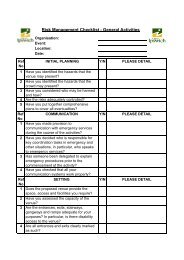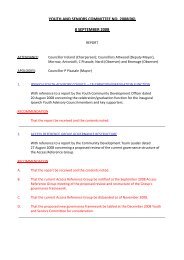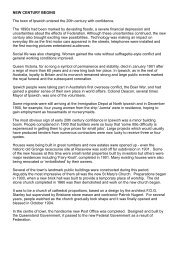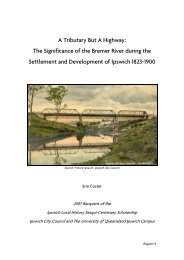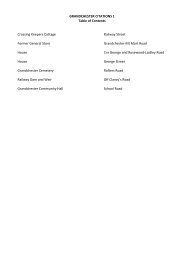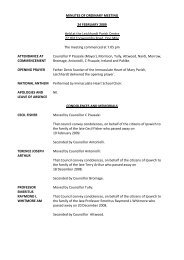Fact Sheet 5 - Water Quality (PDF, 217 kb) - Ipswich City Council
Fact Sheet 5 - Water Quality (PDF, 217 kb) - Ipswich City Council
Fact Sheet 5 - Water Quality (PDF, 217 kb) - Ipswich City Council
You also want an ePaper? Increase the reach of your titles
YUMPU automatically turns print PDFs into web optimized ePapers that Google loves.
FACT SHEET 5<br />
<strong>Water</strong> <strong>Quality</strong><br />
<strong>Water</strong> is our most valuable, natural resource, providing habitat for wildlife, water for households, factories<br />
and farms, and provide recreational and educational benefits for the whole community. <strong>Water</strong> quality<br />
provides essential ecosystem services that contribute to the lifestyles and livelihoods of the <strong>Ipswich</strong><br />
community.<br />
Poor water quality poses threats to:<br />
• Human health and well-being<br />
• <strong>Water</strong>way health and functions<br />
• Reliability and quality of water supply<br />
• Recreation and liveability values<br />
• Agricultural use and livestock<br />
health<br />
• Aquatic life<br />
• Economic development, and<br />
• Preservation of water resources for<br />
future generations.<br />
Impacts on water quality can be categorised into four broad areas:<br />
• Point Source Pollution<br />
• Urban Diffuse Source Pollution<br />
• Non-urban Diffuse Source Pollution, and<br />
• Peak Flows / Urban Stormwater run-off<br />
The major threat to water quality is increased levels of sediment, nutrients, organic carbon,<br />
heavy metals, litter and other wastes from a wide range of sources. The number of potential<br />
contributors is very large, making urban diffuse pollution difficult to trace and manage,<br />
they include:<br />
• Urban development sites<br />
• Commercial and industrial sites<br />
• Stormwater<br />
• Roads<br />
Non-urban diffuse pollution is the input of sediment and nutrient loads derived<br />
from gully and channel erosion. Grazing, clearing and loss of riparian vegetation<br />
is the most significant cause of non-urban diffuse source pollution on water<br />
quality in <strong>Ipswich</strong>. High sediment loads impact on water quality, aquatic flora<br />
and fauna, and channel morphology. Pollutants include sediments, nutrients,<br />
herbicides, and pesticides originating from:<br />
• Rural landscapes<br />
• Septic systems<br />
• Rising water tables<br />
PAGE 1<br />
For further information contact<br />
<strong>Ipswich</strong> <strong>City</strong> <strong>Council</strong><br />
Phone: (07) 3810 6666<br />
www.ipswich.qld.gov.au
FACT SHEET 5<br />
Peak flows / urban stormwater run-off is a significant factor in the degradation of ecosystem health in<br />
urban waterways. Increases in the magnitude of stormwater discharges and the frequency of run-off<br />
events, due to introduction of inpermeable areas and direct waterway discharge, can strongly influence<br />
water quality, and diversity of fauna and aquatic habitats in a waterway.<br />
Effective management of stormwater discharge characteristics in urban areas involves challenging<br />
historical urban stormwater design (eg: moving all stormwater away as quickly as possible directly into<br />
urban waterways). <strong>Ipswich</strong> <strong>City</strong> <strong>Council</strong> is investigating alternative systems that can be implemented for<br />
new developments such as retrofitting existing areas to allow the retention, capture, control and reuse of<br />
stormwater at its source.<br />
WATER QUALITY MONITORING<br />
Historically, water was considered to be an unlimited resource and its long term quality and availability were<br />
taken for granted. The combination of this belief with a quest for development led to the exploitation of our<br />
natural resources and a continual decline in the health of our waterways. Furthermore, the fauna and flora<br />
that relied on healthy creek and river systems for survival suffered greatly and their numbers have gradually<br />
declined.<br />
<strong>Water</strong> <strong>Quality</strong> Monitoring allows us to collect regular data of water quality to assess the impacts of these<br />
activities on the overall health of the catchment. Areas of concern can then be investigated and action plans<br />
developed in order to minimise the problem.<br />
It is important to understand that we all live<br />
within a catchment area and that our day to day<br />
activities have the potential to impact on the<br />
health of our waterways. <strong>Water</strong> <strong>Quality</strong> Monitoring<br />
provides an avenue by which community groups and<br />
school students can assess the water quality of their<br />
local creek or river in order to understand the effects of<br />
human activity on the health of the catchment area.<br />
Monitoring also helps to evaluate the effectiveness of<br />
catchment management initiatives.<br />
Some common indicators of environmental<br />
health of the water include:<br />
• temperature<br />
• nitrogen<br />
• fauna and flora surveys<br />
• pH<br />
• turbidity<br />
• conductivity<br />
• dissolved oxygen<br />
• phosphorus<br />
PAGE 2<br />
For further information contact<br />
<strong>Ipswich</strong> <strong>City</strong> <strong>Council</strong><br />
Phone: (07) 3810 6666<br />
www.ipswich.qld.gov.au


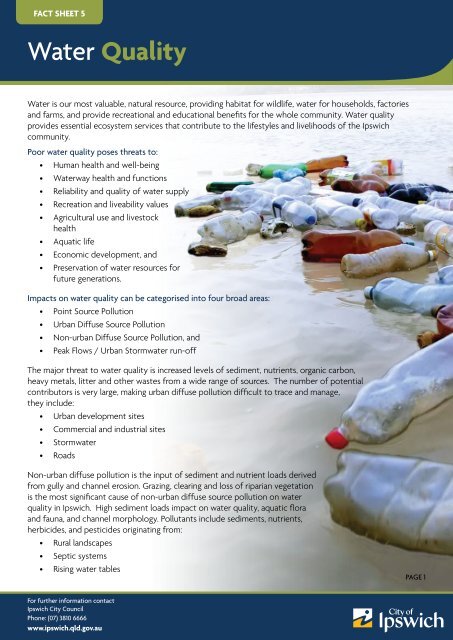
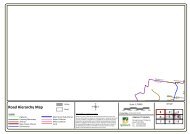
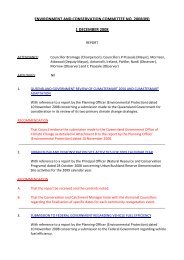
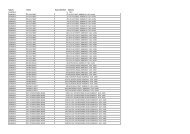
![Historic Homes tell a story [Read-Only] - Ipswich City Council](https://img.yumpu.com/23496138/1/190x146/historic-homes-tell-a-story-read-only-ipswich-city-council.jpg?quality=85)
